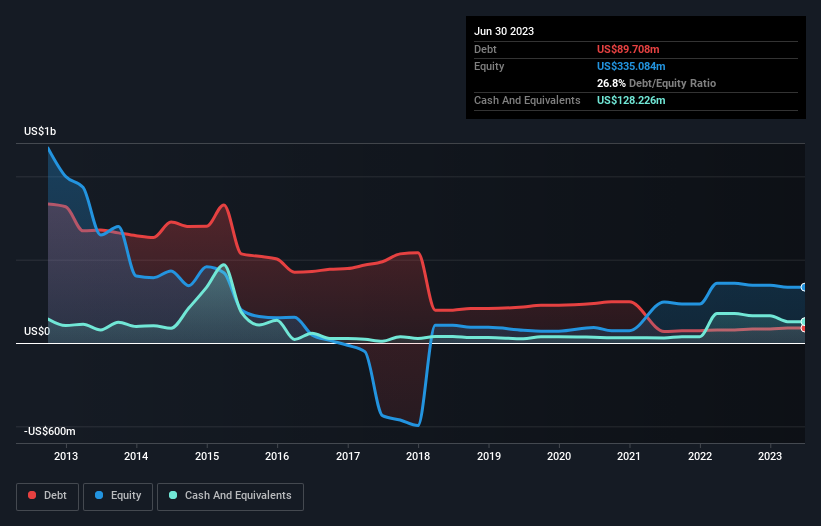Howard Marks put it nicely when he said that, rather than worrying about share price volatility, 'The possibility of permanent loss is the risk I worry about... and every practical investor I know worries about.' So it seems the smart money knows that debt - which is usually involved in bankruptcies - is a very important factor, when you assess how risky a company is. We note that Paladin Energy Ltd (ASX:PDN) does have debt on its balance sheet. But should shareholders be worried about its use of debt?
When Is Debt Dangerous?
Debt is a tool to help businesses grow, but if a business is incapable of paying off its lenders, then it exists at their mercy. Part and parcel of capitalism is the process of 'creative destruction' where failed businesses are mercilessly liquidated by their bankers. While that is not too common, we often do see indebted companies permanently diluting shareholders because lenders force them to raise capital at a distressed price. Of course, plenty of companies use debt to fund growth, without any negative consequences. When we examine debt levels, we first consider both cash and debt levels, together.
View our latest analysis for Paladin Energy
What Is Paladin Energy's Net Debt?
As you can see below, at the end of June 2023, Paladin Energy had US$89.7m of debt, up from US$78.6m a year ago. Click the image for more detail. But it also has US$128.2m in cash to offset that, meaning it has US$38.5m net cash.

A Look At Paladin Energy's Liabilities
According to the last reported balance sheet, Paladin Energy had liabilities of US$9.58m due within 12 months, and liabilities of US$128.4m due beyond 12 months. Offsetting these obligations, it had cash of US$128.2m as well as receivables valued at US$2.76m due within 12 months. So its liabilities total US$6.98m more than the combination of its cash and short-term receivables.
Having regard to Paladin Energy's size, it seems that its liquid assets are well balanced with its total liabilities. So it's very unlikely that the US$1.71b company is short on cash, but still worth keeping an eye on the balance sheet. While it does have liabilities worth noting, Paladin Energy also has more cash than debt, so we're pretty confident it can manage its debt safely. There's no doubt that we learn most about debt from the balance sheet. But it is future earnings, more than anything, that will determine Paladin Energy's ability to maintain a healthy balance sheet going forward. So if you're focused on the future you can check out this free report showing analyst profit forecasts.
Given its lack of meaningful operating revenue, Paladin Energy shareholders no doubt hope it can fund itself until it can sell some combustibles.
So How Risky Is Paladin Energy?
Statistically speaking companies that lose money are riskier than those that make money. And we do note that Paladin Energy had an earnings before interest and tax (EBIT) loss, over the last year. And over the same period it saw negative free cash outflow of US$49m and booked a US$11m accounting loss. But the saving grace is the US$38.5m on the balance sheet. That kitty means the company can keep spending for growth for at least two years, at current rates. Summing up, we're a little skeptical of this one, as it seems fairly risky in the absence of free cashflow. The balance sheet is clearly the area to focus on when you are analysing debt. But ultimately, every company can contain risks that exist outside of the balance sheet. For example - Paladin Energy has 1 warning sign we think you should be aware of.
If you're interested in investing in businesses that can grow profits without the burden of debt, then check out this free list of growing businesses that have net cash on the balance sheet.
New: Manage All Your Stock Portfolios in One Place
We've created the ultimate portfolio companion for stock investors, and it's free.
• Connect an unlimited number of Portfolios and see your total in one currency
• Be alerted to new Warning Signs or Risks via email or mobile
• Track the Fair Value of your stocks
Have feedback on this article? Concerned about the content? Get in touch with us directly. Alternatively, email editorial-team (at) simplywallst.com.
This article by Simply Wall St is general in nature. We provide commentary based on historical data and analyst forecasts only using an unbiased methodology and our articles are not intended to be financial advice. It does not constitute a recommendation to buy or sell any stock, and does not take account of your objectives, or your financial situation. We aim to bring you long-term focused analysis driven by fundamental data. Note that our analysis may not factor in the latest price-sensitive company announcements or qualitative material. Simply Wall St has no position in any stocks mentioned.
About ASX:PDN
Paladin Energy
Through its subsidiaries, engages in the development and exploration of mineral properties in Australia, Canada, and Namibia.
High growth potential with adequate balance sheet.
Similar Companies
Market Insights
Community Narratives




